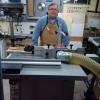I am panning to move my workshop into the basement and not sure what to do with all equipment like furnace, power panel, washer-drier, heater, etc. Basement setup is quite not friendly, there is just no place that can be isolated into separate room. Please take a look at attachet rough layout drawing.
It's all one open space and I got permission to use use as much as 50% for my woodworking needs. Furnace is HE forced and has no intakes in the basement.
So here are some options I came up with:
1. I can build a wall isolating half of the basement and cover power+cable+phone wall stuff with enclosure with some access doors. Not sure if it's allowed to cover all that stuff.
2. I can build a room with two walls leaving walkway to power panel but in this case shop area will be not as large as i need.
3. I can destroy storage rooms and rebuild them on the other side of basement and use that area to build workshop room. I still have to cover water pump/filters/softener/sump pump somehow. This option is rather work intence.
Not planning for now any dust control system. Just huge shopvac and separate ventilation fan to outside.
Any advice will be highly appreciated!




 Reply With Quote
Reply With Quote







